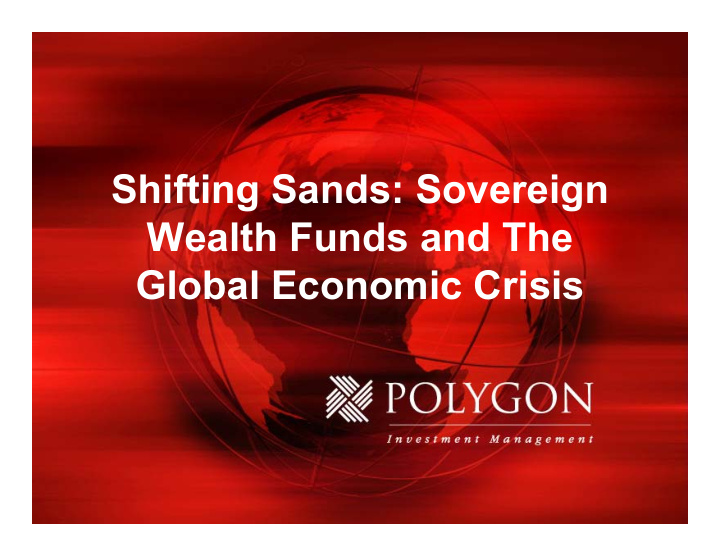



Shifting Sands: Sovereign Wealth Funds and The Global Economic Crisis
Select Arab Sovereign Wealth Funds Country Name Created Est. size (billions) Kuwait Kuwait Investment Authority (KIA) 1953 $213 Qatar Qatar Investment Authority (QIA) 2003 $60 Saudi Arabia Saudi Arabian Monetary Agency (SAMA) 1952 $500 UAE (Abu Dhabi) Abu Dhabi Investment Authority (ADIA) 1976 $400-500 UAE (Abu Dhabi) International Petroleum Investment Company (IPIC) 1984 $12 UAE (Abu Dhabi) Mubadala Development Company 2002 $10 UAE (Dubai) Istithmar World 2003 $12 UAE (Dubai) Dubai International Capital 2004 $13 UAE (Dubai) Investment Corporation of Dubai 2006 $82 Source: Edwin M. Truman, “A Blueprint for Sovereign Wealth Fund Best Practices,” Policy Brief 08-3, (Washington, D.C.: Peterson Institute for International Economics, April 2008), Polygon assessments.
Maximizing Return on Investment Long Term payout, Infrastructure increased absorptive capacity Oil Current Political benefits Revenues Consumption Domestic Surplus Foreign
Types of SWF’s Central Bank Long Term Investors Domestic Synergy Example SAMA ADIA, KIA, QIA Mubadala Dubai Investment Conservative Specialist Domestic Focus Characteristics Risk Averse Risk-Oriented More Entrepreneurial Indigenous Workforce Dependant on Ex-Pats Methodology Excluding FX Reserves – Primarily External Managers Internally Managed 3 rd Party Managed Joint-Ventures Bond-Oriented Primarily Equities and Alternative Direct Investments Investment Investments Strategy
A Tale of Two Markets 2006-07 2008-09 Both oil prices and production surge Prices and production plummet Saudi current account surpluses averaged over $100 bil. GCC current account surpluses Qatar and UAE had surpluses of almost 50% p.a narrow dramatically Global and local stock markets leap ahead Global equity meltdown SWF assets increased dramatically Major local markets down 70% Combined losses of ADIA and KIA of $250 billion Overseas direct investments swell $40 billion invested into foreign financial institutions Generate higher profile Domestic economy and banks propped up Antagonism in West Increased needs both locally and in West Cyclicality has not been repealed. Global imbalances remain
Source: B. Setser, Council on Foreign Relations
Source: B. Setser, Council on Foreign Relations
Estimated Distribution of Foreign Investments REGION ASSET CLASS US- 50% Public Equity- 50% EUROPE- 30% Alternative Strategies- 15% MENA- 10% Fixed Income- 35% ASIA- 10%
Domestic Economy Priorities • Capture value added from investments • Develop infrastructure • Create institutional framework • Diversify away from dependency on oil • Generate employment • Counter cyclical buffer
Conclusions • Reciprocal political risk and interdependence with West • Symbolizes global shift in economic power • Potential contribution to local development • Reinforces State domination
Recommend
More recommend